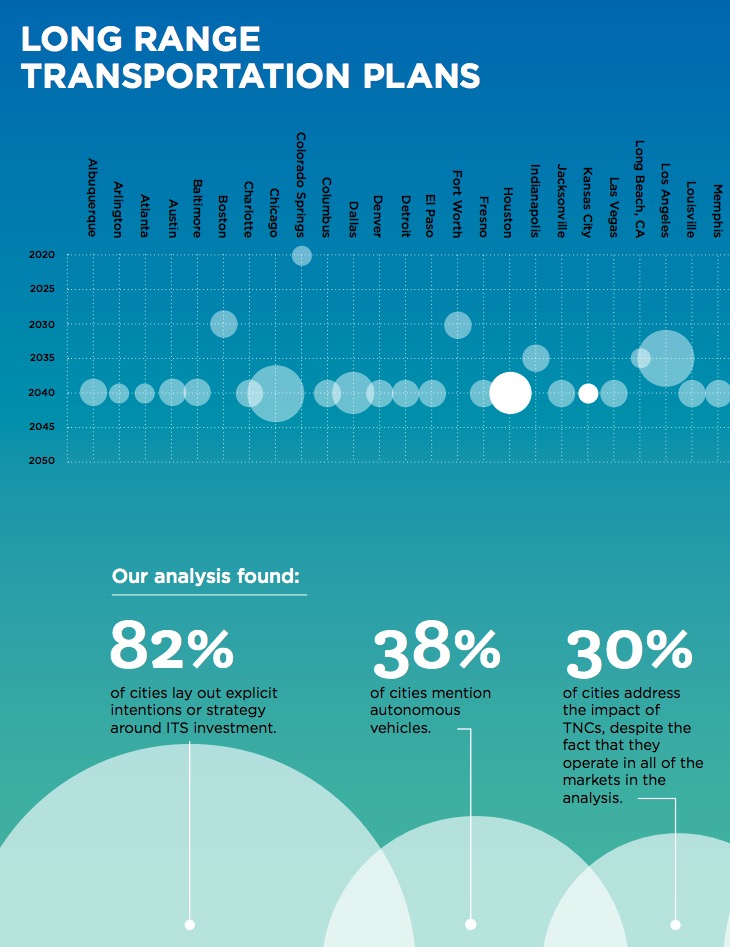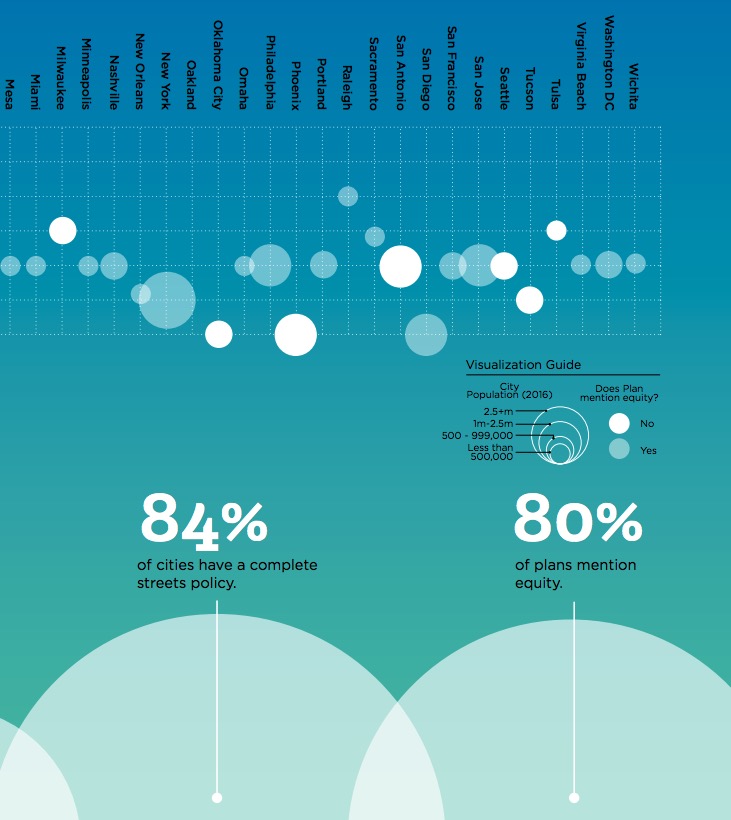NATIONAL LEAGUE OF CITIES
In order to examine factors at the nexus of equity, mobility and technology, we analyzed long range transportation plans from the 50 largest U.S. cities. In 19 of these cities, there were up-to-date (adopted after 2010) municipal transportation plans available. The remaining plans in the analysis are regional long-range transportation plans.
Mobility is critical to humanity’s growth in the urban environment.
It is one of the major facilitators of human settlement and success. Where an individual goes, how they get there and the resources they have access to has the potential to influence nearly every other element of his or her life. As mobility and adequate infrastructure have become more widely regarded as civil rights, central to inclusion and critical to individuals’ capacity to participate and prosper in the modern-day economy, they have simultaneously been significantly impacted by the overwhelming tide of technological forces.
Creating and sustaining a transportation network – a platform for commerce and human interaction – is one of the oldest and most important functions of government. However, as advancements in technology have occurred in concert with the development of new modes of transportation, this function has changed drastically.
New technology is promising a hyperconnected future for cities in which driverless cars and smart city applications have the potential to improve services, efficiency and quality of life. We can imagine a not too distant future in which every consumer product and piece of infrastructure increasingly has the ability to sense surrounding stimuli, to communicate with other devices and people, and to draw on the computing and storage power of the cloud.
However, along with all of these exciting advances come a bevy of new questions about equity. Will the technologically driven city and mobility network of the future serve everyone? Will individuals have digital autonomy? How will we protect privacy? As we experience this moment of seemingly monumental transition, how do we ensure that low income communities and communities of color are not left further behind? With current demographic shifts, generational preferences, wealth creation and other factors pointing toward the continued growth of cities, the importance of mobility and infrastructure is ever-present. Simultaneously, the recognition that equity is driven and sustained by these forces presses city officials to ask new questions and prepare for a new future.
Infrastructure: 2020
More communities will move toward accessibility and multi-modalism as communities across America invest in and build out their transit systems.
Even as the mobility sector continues to change drastically, communities of all sizes across the country continue to invest in more traditional transit. Citizens are more willing than ever to make investments in new and improved transit systems. In 2016 there were 77 local measures on the ballot that proposed voters paying taxes, fees, or other funding or financing mechanisms to pay for transit or transportation related projects. This was the highest number of transportation ballot measures in one calendar year to date, and 71 percent of these ballot measures were passed by voters. This data is consistent with previous years. Since 2000, there has been an overall 71 percent approval rate of these types of ballot measures, even during politically polarizing ebbs and flows dominated by antitax sentiment.
Currently we see many cities embarking on new transit projects and building out existing systems, with bus-rapid-transit (BRT) and streetcar systems gaining momentum and support. In 2017 there will be 10 new BRT lines opening in cities across the county, and six projects beginning construction that will likely be in service within the next five years. There are also two new streetcar lines opening and four planned that will be either well underway or finished in this time frame.
By 2020, expansion and improvement of transit systems and movement toward community design that favors accessibility and multi-modalism will enable more individuals to get to the places that they live, work, play, and pray without relying on the increasingly exorbitant expense of a single occupancy vehicle.
Smart city applications will be deployed in a more standardized and comprehensive way, and in cities of all sizes.
The conversation around smart cities has been largely driven by the private sector and aimed toward large cities with the organizational and budget capacities to do expansive projects. However, small and medium sized cities are beginning to see that smart city solutions can and should be deployed in an iterative manner and in a way that is consistent with their objectives. Context sensitivity is a primary consideration in the deployment of smart cities and small and mid-sized cities don’t necessarily face the same problems as large cities.
As cities of all sizes begin to implement and explore smart city solutions, context and scale are front of mind for local leaders. A recent NLC survey asked cities whether they had invested in any sort of smart city technology, and 66 percent of city officials surveyed said yes. When asked about which types of smart city solutions they had adopted, they cited smart meters for utility management, intelligent traffic signals, e-governance applications, wifi kiosks and RFID sensors in pavement, among many others. Of the 34 percent of cities without any smart city systems in place, a quarter said their cities were currently exploring implementing some sort of smart city application.
As these technologies becomes more commonplace in cities of all sizes and geographies, they have the potential to bridge some of the divides that exist between communities and their municipal government officials. In many cases, smart city solutions automatically inform city departments of deficiencies or areas where attention is needed rather than relying on communication or reporting from individuals who might not be comfortable interfacing with government institutions.
To date, one of the challenges related to deployment of smart city infrastructure is the lack of interoperability. Though not yet fully implemented, the National Institute of Standards and Technology (NIST) is working in conjunction with a number of other organizations on a framework for smart city development. The framework is designed to address two main concerns: the interoperability and portability of information and communications technology (ICT) development across cities, and the need for standard architectural principles. Their goal is to establish enough standardization that systems can be integrated across cities, without standardizing so much as to create an obstacle for further innovation. With some of the interoperability challenges removed, more cities and regions will be able to continuously roll out new smart city applications to make the lives of their residents easier and more seamless. By 2020, smart city applications and systems might look different, but ultimately, they will be more commonplace, seamless, and effective across locales.
Autonomous vehicle pilots will exist in all 50 states and fleets will be deployed in many communities.
Over the course of a few years, there has been significant policy movement toward autonomous vehicle (AV) testing. Twenty states have thus far passed legislation related to AVs. Additionally, governors in Arizona, Massachusetts, Washington and Wisconsin have issued executive orders related to the operation, testing or regulation of autonomous vehicles. In January of 2017, the Department of Transportation (USDOT) announced 10 proving grounds to move autonomous vehicles testing from controlled to real world vehicle operating environments, with a focus on developing best practices for data sharing as well as future policy guidance.
In addition to initiating testing programs, some cities, are deploying fleets of AVs. The introduction of autonomous Uber fleets in cities like Pittsburgh, Pennsylvania, and Tempe, Arizona, has gained significant attention. Between federal, state and local level action, some sources predict that driverless car pilots might be deployed in up to 30 cities by the end of 2017. We can expect that several other cities will invite similar testing fleets and programs into their jurisdictions by 2020. In addition to pilot programs focused on ridesharing or single-occupancy use, we can also expect to see testing in the transit and freight sectors. Cities’ usage of autonomous and connected vehicle technology in service fleets will also become much more common over the next 3-5 years.
This will have significant equity implications, as these pilots will set in motion any regulatory efforts that take place around AVs in these jurisdictions in the years to come.
Download full report (PDF): The Future of Equity in Cities
About the National League of Cities
www.nlc.org
The National League of Cities was founded in December 1924 by 10 state municipal leagues that saw the need for a national organization to strengthen local government. Established initially as the American Municipal Association, it was an organization comprised only of state municipal leagues, whose purpose was to collect and exchange information about urban affairs that would help state organizations promote approved methods of municipal government. Today, more than 1,600 cities, towns, and villages of all sizes are NLC members and another 18,000 communities participate through their state municipal leagues. Local elected leaders from even the smallest cities now have an opportunity to shape the priorities, policies, and advocacy positions of the organization. With the door to leadership and participation open to all local elected officials, NLC is now as diverse as the communities it serves.








 RSS Feed
RSS Feed